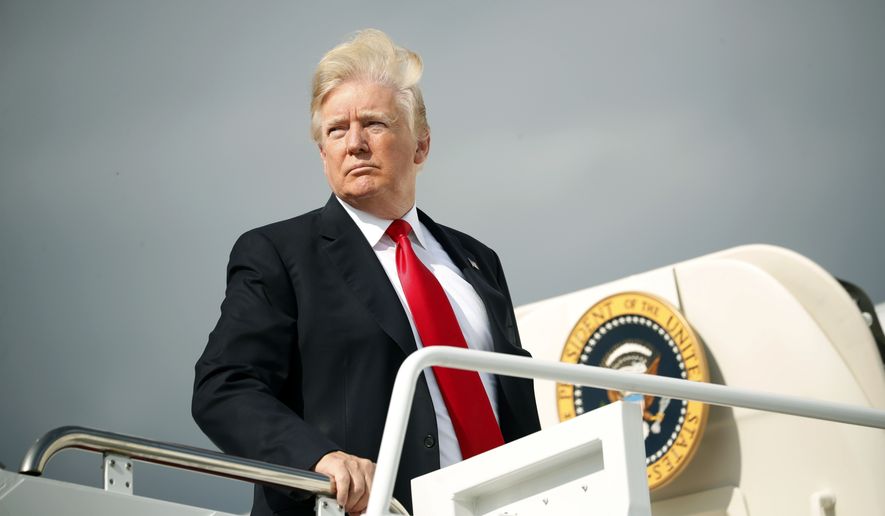In a bold break with diplomatic convention, President Trump is heading into a high-stakes summit with North Korean leader Kim Jong-un on Tuesday without a completed deal on the table.
While conversations at the White House about how to conduct the negotiations are developing day by day, according to sources, Mr. Trump has made it clear that he will lead the deal-making when he gets to the Singapore summit.
The potential for on-the-fly negotiations is fueling a White House debate about what — if any — concessions Mr. Trump should offer in exchange for North Korea’s concrete steps toward dismantling nuclear weapons and nuclear weapons facilities.
“It is up to North Korea to indicate what it is willing to do prior to the U.S. once again tossing benefits to the North to try to get it to comply with international law and U.N. resolutions,” said Bruce Klingner, a scholar at the conservative Heritage Foundation who once ran the CIA’s Korea branch.
He described the offer of U.S. concessions as “the policeman sitting across from the criminal saying, ’OK, this is what I’ll give you to have you return to compliance with the law.’ It shouldn’t be that way.”
Mr. Klingner echoed the Korea hawks at the White House who oppose any U.S. concession prior to a ironclad commitment from Pyongyang to comply with United Nations resolutions demanding comprehensive, verifiable, irreversible dismantling of the nuclear weapons program, known as CVID in diplomatic circles.
The most strident hawk at the White House is National Security Adviser John R. Bolton. His views are tempered by Secretary of State Mike Pompeo, who has spearheaded the effort on North Korea.
Both men will accompany the president to Singapore.
Mr. Trump appeared to back immediate CVID until last week, when he tamped down expectations for the summit and endorsed a more gradual process.
He also stepped back from using the term “maximum pressure” to describe the sanctions campaign against Mr. Kim’s communist regime. The severe sanctions, coupled with support from China in cutting off North Korea, helped bring Mr. Kim to the negotiating table.
Mr. Klingner said the president had “watered down” the U.S. demands for CVID.
“We are not quite certain if that is still the policy or whether by Trump saying take your time to North Korea he is indicated a phased, more methodical implementation,” he said.
Mr. Trump has floated offers of security assurances for the Kim regime, economic aid and normalized relations, although the administration refuses to consider reducing the force of roughly 28,000 U.S. troops in South Korea.
The details of these offers and what actions North Korea would take to trigger implementation could be decided in Singapore.
The president also said the summit is just the beginning of a series of talks to hammer out a denuclearization deal.
The prospect of follow-up meetings ginned up speculation that Mr. Kim had invited the president to Pyongyang and that Mr. Trump was considering inviting Mr. Kim to the president’s Mar-a-Lago Club in Palm Beach, Florida.
The White House has kept the focus on the Singapore meeting, viewing it as the crucial first step toward resolving the North Korea threat.
Expectations run high that the two leaders will emerge from the summit with an agreement to formally end the Korean War after a 60-year standoff and a commitment to dismantling the North’s nuclear arsenal and long-range missiles.
Still, Mr. Trump broke with conventional wisdom by simply agreeing to the summit. The move was widely criticized for providing legitimacy to Mr. Kim, a brutal dictator. Yet the summit already has netted concessions from Pyongyang, including a halt to nuclear and missile tests and the return of three U.S. citizens imprisoned in North Korea.
“We’re already way ahead here,” said White House adviser Kellyanne Conway.
It should come as no surprise that Mr. Trump, who repeatedly bucks convention, would walk into the summit without a prearranged deal. A summit of this magnitude typically takes place only after a deal is finalized, ensuring that the president arrives for a photo-op that cannot go wrong.
“This is kind of gutsy, but in my view — and I think others share it — it was the right decision,” said Joseph R. DeTrani, the former U.S. special envoy to failed multilateral talks with North Korea.
He said Mr. Trump has considerable leverage in the negotiations and plenty of offers to dangle in front of Mr. Kim.
“North Korea will get a great number of deliverables if they move forward with comprehensive, verifiable, irreversible denuclearization,” said Mr. DeTrani. “They get security assurances, which includes certainly the normalization of relations with the United States, a peace treaty to end the Korean War, a nonaggression pact and economic development.”
Mr. Trump repeatedly said he is prepared to walk away from the table if he doesn’t like the deal.
While the deal hasn’t been sketched out in advance, both sides understand the other’s overarching goals and they come to Singapore wanting to reach an accord.
“This is not something that is going to be done in one fell swoop,” Mr. DeTrani said. “Hopefully it can be done as expeditiously as possible, but I think we have to be realistic. It’s not going to happen all in one meeting.”
• Dave Boyer contributed to this article.
• S.A. Miller can be reached at smiller@washingtontimes.com.




Please read our comment policy before commenting.